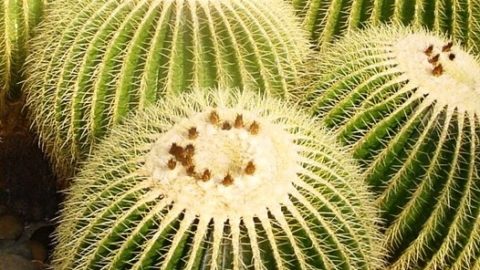Some 300 miles southeast of Mexico City lies the Tehuacan-Cuicatlan Valley. It is generally thought that it was here, in the heart of it, that the genus Ferrocactus originated and subsequently radiated northward and westward.
The Tehuacan-Cuicatlan Valley is important because it contains, probably, the highest biological diversity for an arid-zone in all of North America. For example, the 10,000 square-kilometer area boasts an amazing 2,703 flowering plant species. Of these, nearly 30% are endemic to the region.
The genus Ferocactus was segregated from the closely related Echinocactus in 1922, by two American taxonomists. The two genera can be distinguised quite easily; the former having nectar glands on the apical portion of the areoles, the crown and flowers absent of woolly hairs, the fruit fleshy, whereas, the latter having a crown of pale woolly hairs (almost like a nest) and dry, mature fruits. Its extrafloral nectaries produce an ant-attracting nectar of varied sugar composition. It is believed that these extrafloral nectaries create an important mutalistic relationship in which the plant derives protection from unwanted herbivores in exchange for providing food for the ant. Also of interest is that the genus contains important polyphenol compounds, such as phenolic acids, lignins, tannins, and flavinoids, which act as strong antioxidants that aid in the control of bacterial diseases. Polyphenols are well known for their anticancer, cardioprotective, anti-inflammatory, and antimicrobial properties. How cool is that!
Ferocactus glaucescens is one of about 30 species native to Mexico and the southwestern United States. Joseph Nelson Rose, a botanist and assistant curator at the Smithsonian, collected F. glaucescens in the area of Toliman, Mexico, northwest of Mexico City. He and Nathaniel Lord Britton, of the New York Botanical Garden, named and described the species in 1922, replacing the name, Echinocactus glaucescens, that had been employed by Augustin Pyramus de Candolle, in 1828. Ferocactus is closely allied to both Echinocactus and Stenocactus species.



At least 16 species of Ferocactus grow in the Sonoran Desert of Baja, California and in the Sonoran and Chihuahuan deserts of central Mexico.
FEROCACTUS of BAJA, CALIFORNIA
- F. chrysacanthus
- F. diguetii
- F. fordii
- F. gatesii
- F. gracilis
- F. johnstonianus
- F. peninsulae
- F. rectispinus
- F. townsendianus
- F. viridescens
FERAOCACTUS of CENTRAL MEXICO
- F. flavovirens
- F. hewrrerae
- F. glaucescens
- F. latispinus
- F. robustus
- F. stainesii



